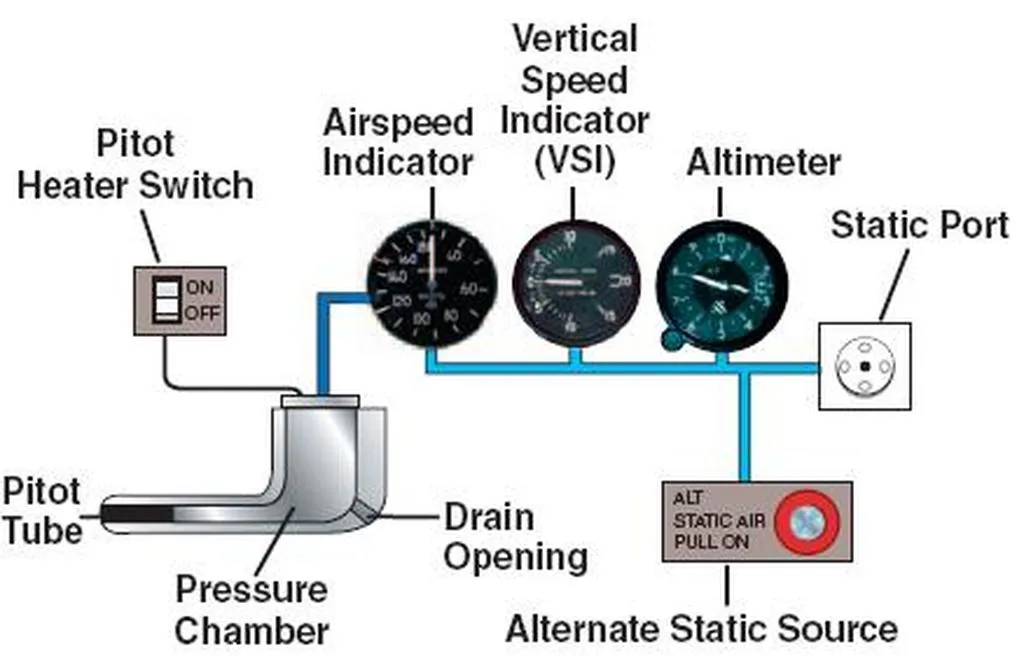Understanding pitot static system failures is critical for maintaining flight safety. The pitot-static system supplies the vital information pilots need to control airspeed, altitude, and vertical speed. Failures in this system can quickly escalate into dangerous situations if not promptly detected and properly managed. This detailed guide explores the common causes, symptoms, and preventative measures related to pitot-static system failures, providing the knowledge necessary to ensure safer flights.
Why Pitot Static Systems Are Critical
The pitot-static system is the backbone of several key flight instruments:
- Airspeed Indicator (ASI): Measures the aircraft’s speed relative to surrounding air.
- Altimeter: Displays the aircraft’s altitude above sea level.
- Vertical Speed Indicator (VSI): Shows the rate of climb or descent.
These instruments rely on precise measurements of static air pressure and dynamic (ram) air pressure. If either source becomes compromised, the resulting incorrect readings can severely impact situational awareness, especially in instrument meteorological conditions (IMC).
Modern aviation relies heavily on the accuracy of these instruments. Misleading or erroneous readings due to pitot-static failures have been implicated in numerous aviation accidents, making it essential for pilots to understand not just how these systems work, but also how they can fail.
1. Pitot Tube Blockage
A pitot tube blockage is one of the most common types of pitot-static system failures and poses a significant threat to flight safety.
A pitot tube is a small, forward-facing device on an aircraft designed to measure dynamic, or ram, air pressure created by the aircraft’s movement through the air. This pressure is critical for calculating the airspeed, as it directly feeds into the airspeed indicator. Positioned typically on the wing or nose to avoid disturbed airflow, the pitot tube captures air as the aircraft moves forward.
By comparing this dynamic pressure with the static air pressure sensed elsewhere on the aircraft, the pitot-static system determines how fast the aircraft is traveling through the air mass. A pitot tube blockage can prevent accurate airspeed readings, which can dramatically compromise the safety of the flight.
Causes of Pitot Tube Blockage
Several factors can obstruct the pitot tube:
- Ice Formation: In-flight icing can clog the pitot tube if pitot heat is not activated.
- Insects and Debris: Mud daubers and other insects can nest in pitot tubes during ground time.
- Dirt and Foreign Objects: Dust, debris, and even rainwater can cause blockages.
- Forgotten Covers: Failing to remove pitot tube covers before flight is a surprisingly common preflight error.
Symptoms of Pitot Tube Blockage
When the pitot tube is blocked but the static ports remain clear, the airspeed indicator becomes unreliable:
- Frozen Airspeed: If the blockage occurs while maintaining constant pressure, the airspeed will freeze.
- Climb and Descent Errors: Airspeed readings will drop during a climb and increase during a descent, which is the reverse of what normally happens.
The altimeter and VSI will continue to function normally, potentially masking the problem if the pilot relies solely on the airspeed indicator.
Prevention and Response
- Preflight Inspection: Always inspect the pitot tube before flight.
- Use Pitot Heat: Engage pitot heat when flying in visible moisture or temperatures near freezing.
- Instrument Cross-Check: Cross-reference the airspeed indicator with the GPS groundspeed, altimeter, and VSI.
- Power and Attitude Flying: Be proficient in using known power settings and aircraft attitude to maintain flight when airspeed information is unreliable.
Accidents: The Air France Flight 447 disaster, where ice crystals blocked the pitot tubes leading to loss of airspeed data and subsequent stall, highlights the deadly consequences of a pitot tube blockage.
2. Static Port Blockage
A static port blockage disrupts the aircraft’s ability to sense ambient atmospheric pressure, affecting several key instruments. The static port is a small, carefully placed opening that measures outside air pressure, providing a reference point for instruments like the altimeter, vertical speed indicator, and airspeed indicator. It works alongside the pitot tube, which measures dynamic pressure, to deliver accurate flight data.
Causes of Static Port Blockage
- Ice Formation: Blockages due to ice if static port heating systems are inadequate.
- Maintenance Errors: Tape left over ports after servicing.
- Environmental Contaminants: Volcanic ash, dirt, or other particulates.
Symptoms of Static Port Blockage
- Frozen Altimeter: Altitude remains fixed.
- Zero VSI: Vertical speed remains stuck or incorrect.
- Airspeed Errors: During climbs and descents, the airspeed may behave contrary to expectations.
Prevention and Response
- Preflight Checks: Inspect static ports and ensure they are free from obstruction.
- Use of Alternate Static Source: Most aircraft have a cockpit-activated alternate static source, though it typically reads slightly lower pressure.
- Instrument Cross-Check: Compare GPS altitude with the altimeter.
- Emergency Procedures: If available, break the glass on the VSI to create a temporary alternate static source (as a last resort).
Static blockages are dangerous because they simultaneously compromise multiple instruments, complicating troubleshooting during flight.

3. Pitot-Static Line Leakage
A less obvious but serious issue is a pitot-static line leakage, which can distort pressure readings.
Causes of Pitot-Static Line Leaks
- Aging Aircraft: Deterioration of hoses and connectors.
- Maintenance Errors: Improper reconnection after maintenance.
- Environmental Wear: Vibration and temperature extremes causing cracks.
Symptoms of Pitot-Static Line Leakage
- Gradual Instrument Inaccuracy: Small errors that progressively worsen.
- Unexplained Discrepancies: Variations between indicated and actual performance.
- Single Instrument Deviation: Sometimes only one gauge is affected.
Prevention and Response
- Scheduled Maintenance: Regularly inspect lines for integrity.
- Cross-Check Instruments: Verify readings with backup systems like GPS.
- Recognition of Subtle Errors: Be alert to slight but consistent deviations.
Because pressure differences are so small, even minor leaks can have serious consequences over time.
4. Internal Instrument Failure
Internal failure of instruments can mimic pitot-static problems.
Causes of Internal Instrument Failure
- Mechanical Wear: In aneroid capsules, gears, or linkages.
- Electronic Failures: Digital flight displays losing data or corrupting output.
- Moisture Intrusion: Damaging sensitive internal components.
Symptoms of Instrument Failure
- Erratic Readings: Fluctuating or frozen displays.
- Blank Displays: In glass cockpit systems.
- Single Instrument Anomalies: Unlike system blockages that affect multiple gauges.
Prevention and Response
- Routine Instrument Calibration: Ensure instruments meet maintenance specs.
- Partial Panel Training: Be comfortable flying with limited instruments.
- Cross-Verification: Compare instrument readings with independent systems.
Internal failures highlight the importance of redundancy and staying proficient with basic flight skills.
5. Drain Hole Blockage
A drain hole blockage might seem minor but can escalate into major system failures.
Purpose of Drain Holes
Drain holes in pitot and static ports allow accumulated moisture to escape. If blocked, trapped moisture can freeze and expand, blocking the system.
Causes of Drain Hole Blockage
- Debris Accumulation: Dirt, insects, or mud.
- Moisture Freezing: Water inside the lines expanding into ice.
Symptoms
- Intermittent Errors: Especially in cold weather.
- Sudden Failures: If frozen water blocks the system entirely.
Prevention and Response
- Drain Hole Inspections: Regular maintenance to ensure they are clear.
- Moisture Awareness: Be cautious after flights in rain or high humidity.
- Proactive Pitot Heat Use: Especially in icing conditions.
Proper care and regular inspections prevent this often-overlooked failure mode.
6. Multiple System Failures
A multiple system failure is the most dangerous pitot-static scenario.
Causes of Multiple Failures
- Severe Icing: Simultaneous blockages of pitot and static ports.
- Volcanic Ash Ingestion: Leading to widespread contamination.
- Extreme Turbulence: Damaging multiple system components.
Symptoms
- Loss of Redundancy: Primary and backup instruments unreliable.
- Erratic Readings Across the Panel: Altitude, airspeed, and vertical speed all compromised.
Prevention and Response
- Avoidance: Stay clear of known icing and ash clouds.
- Partial Panel Skills: Fly using power settings, attitude, and GPS groundspeed.
- GPS Limitations: GPS provides groundspeed, not true airspeed.
- Emergency Descents: Prepare to descend to VFR conditions if possible.
Developing the ability to “fly the airplane” without reliable instruments is critical to survival in such scenarios.
Final Thoughts on Pitot Static System Failures
Understanding the various pitot static system failures and their symptoms equips pilots with the knowledge needed to detect and respond to problems before they escalate into emergencies. Thorough preflight inspections, vigilant in-flight cross-checking, and proficiency in basic flying techniques are all crucial defenses against these potentially life-threatening failures.
Regular simulator training that includes pitot-static failure scenarios can further enhance preparedness, ensuring that pilots are not only reactive but proactive in maintaining safe flight operations.
In aviation, the margin for error is narrow. Mastering the recognition and management of pitot-static system failures is a non-negotiable part of being a skilled and safety-conscious pilot.
Recent Posts
FAA MOSAIC Final Rule: What Pilots, Manufacturers, and the Aviation Community Need to Know
Learn how the FAA’s MOSAIC final rule revolutionizes Light-Sport Aircraft certification, expands Sport Pilot privileges, and reshapes general aviation. See what’s changing, when it takes effect,...
Student Pilot Insurance: Essential Coverage for Aspiring Flyers
Discover how student pilot insurance can protect your flying dreams. Get expert tips and coverage options to ensure your safety and peace of mind.


